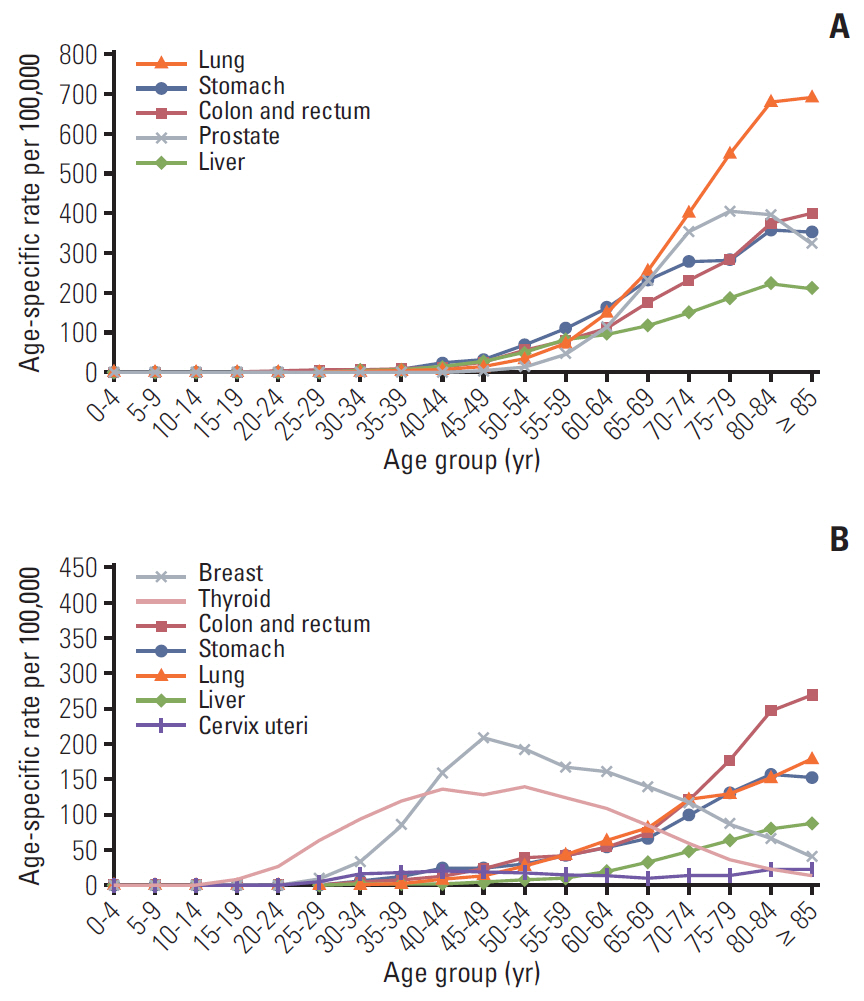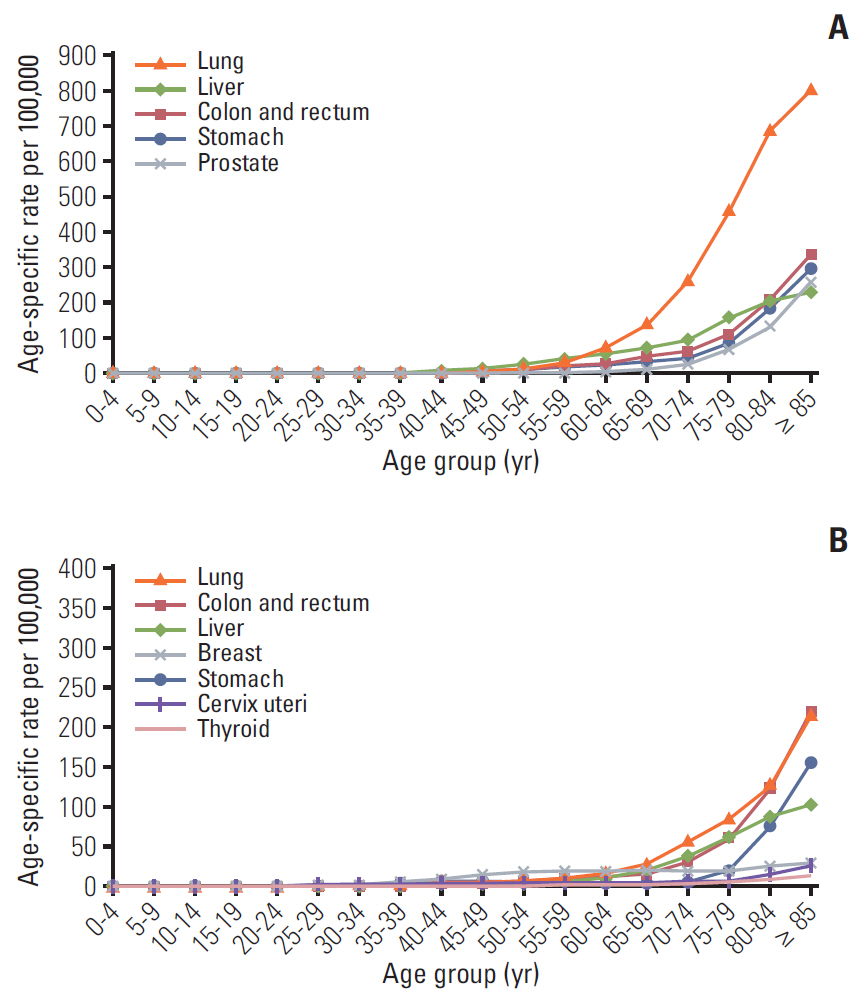Prediction of Cancer Incidence and Mortality in Korea, 2020
- Affiliations
-
- 1Korea Central Cancer Registry, National Cancer Center, Goyang, Korea
- 2Division of Cancer Registration and Surveillance, National Cancer Control Institute, National Cancer Center, Goyang, Korea
- 3Department of Cancer Control and Population Health, National Cancer Center Graduate School of Cancer Science and Policy, National Cancer Center, Goyang, Korea
- 4National Cancer Center Graduate School of Cancer Science and Policy, National Cancer Center, Goyang, Korea
- KMID: 2500320
- DOI: http://doi.org/10.4143/crt.2020.203
Abstract
- Purpose
This study aimed to report the projected cancer incidence and mortality for the year 2020 to estimate Korea’s current cancer burden.
Materials and Methods
Cancer incidence data from 1999 to 2017 were obtained from the Korea National Cancer Incidence Database, and cancer mortality data from 1993 to 2018 were acquired from Statistics Korea. Cancer incidence and mortality were projected by fitting a linear regression model to observed age-specific cancer rates against observed years and then by multiplying the projected age-specific rates by the age-specific population. A Joinpoint regression model was used to determine the year in which the linear trend changed significantly; we only used the data of the latest trend.
Results
In total, 243,263 new cancer cases and 80,546 cancer deaths are expected to occur in Korea in 2020. The most common cancer site is expected to be the lung, followed by the stomach, thyroid, colon/rectum, and breast. These five cancers types are expected to represent half of the overall burden of cancer in Korea. The most common type of cancer among people who die is expected to be lung cancer, followed by liver, colon/rectal, pancreatic, and stomach cancers.
Conclusion
The incidence rates for all types of cancer in Korea are estimated to decrease gradually. These up-to-date estimates of the cancer burden in Korea could be an important resource for planning and evaluating cancer-control programs.
Figure
Cited by 6 articles
-
Enhanced Efficacy of Combined Therapy with Checkpoint Kinase 1 Inhibitor and Rucaparib via Regulation of Rad51 Expression in
BRCA Wild-Type Epithelial Ovarian Cancer Cells
Hye-yon Cho, Yong-Beom Kim, Wook-ha Park, Jae Hong No
Cancer Res Treat. 2021;53(3):819-828. doi: 10.4143/crt.2020.1013.Association among Body Mass Index, Genetic Variants of
FTO , and Thyroid Cancer Risk: A Hospital-Based Case-Control Study of the Cancer Screenee Cohort in Korea
Tung Hoang, Dayoung Song, Jeonghee Lee, Eun Kyung Lee, Yul Hwangbo, Jeongseon Kim
Cancer Res Treat. 2021;53(3):857-873. doi: 10.4143/crt.2020.720.Genetic Susceptibility of ACE2 and TMPRSS2 in Six Common Cancers and Possible Impacts on COVID-19
Tung Hoang, Trung Quang Nguyen, Tho Thi Anh Tran
Cancer Res Treat. 2021;53(3):650-656. doi: 10.4143/crt.2020.950.Do we need to adjust the effect-site concentration of propofol in patients undergoing chemotherapy?
Ki Tae Jung
Korean J Anesthesiol. 2022;75(2):109-111. doi: 10.4097/kja.22098.Anti-adhesive effect and safety of a thermosensitive adhesion barrier (Mediclore) for thyroid surgery: a double-blinded randomized controlled trial
Jong-hyuk Ahn, Sang Gab Yoon, Jin Wook Yi, Su-jin Kim, Kyu Eun Lee
Ann Surg Treat Res. 2022;102(6):313-322. doi: 10.4174/astr.2022.102.6.313.Trend Analysis and Prediction of Hepatobiliary Pancreatic Cancer Incidence and Mortality in Korea
Hyeong Min Park, Young-Joo Won, Mee Joo Kang, Sang-Jae Park, Sun-Whe Kim, Kyu-Won Jung, Sung-Sik Han
J Korean Med Sci. 2022;37(28):e216. doi: 10.3346/jkms.2022.37.e216.
Reference
-
References
1. Statistics Korea [Internet]. Daejeon: Statistics Korea;2020. [cited 2020 Feb 8]. Available from: http://kosis.kr.2. Jung KW, Won YJ, Kong HJ, Lee ES; Community of Population-Based Regional Cancer Registries. Cancer statistics in Korea: incidence, mortality, survival, and prevalence in 2016. Cancer Res Treat. 2019; 51:417–30.
Article3. Shin HR, Won YJ, Jung KW, Kong HJ, Yim SH, Lee JK, et al. Nationwide cancer incidence in Korea, 1999~2001: first result using the National Cancer Incidence Database. Cancer Res Treat. 2005; 37:325–31.
Article4. Fritz A, Percy C, Jack A, Shanmugaratnam K, Sobin L, Parkin DM, et al. International classification of diseases for oncology. 3rd ed. 1st revision. Geneva: World Health Organization;2013.5. World Health Organization. International statistical classification of diseases and related health problems. 10th rev. Geneva: World Health Organization;1994.6. Boyle P, Parkin DM. Cancer registration: principles and methods. Statistical methods for registries. IARC Sci Publ. 1991; (95):126–58.7. National Cancer Institute. Joinpoint regression program, version 4.3.1 [Internet]. Bethesda, MD: National Cancer Institute;2016. [cited 2019 Jul 8]. Available from: http://surveillance.cancer.gov/joinpoint/.8. Segi M. Cancer mortality for selected sites in 24 countries (1950-1957). Sendai: Tohoku University School of Medicine;1960.




